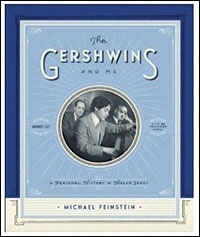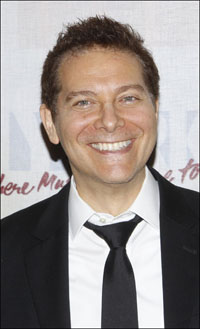
*
Back in the late 1980s, it occurred to me that an effective Broadway revue might be built around the songs of Johnny Mercer. Mercer rarely wrote his own music, of course. This would be an evening with music from diverse composers, the link being the lyrics; one of Mercer's many talents was his ability to bring out the best in his collaborators (or, perhaps, to cherry pick the better melodic ideas they came up with). When I investigated, I was told there was no way this could happen; Margaret Whiting, the pop singer who controlled the Mercer catalogue, was planning a revue of her own and for years had been turning down all requests.
In 1997, finally, came Whiting's Dream, which frustratingly saw fit to obscure Mercer's lyrics as much as possible by hiding them in a haze of ineffective choreography. The show was a quick failure, distinguished by reports of pitched backstage battles centering around star Lesley Ann Warren. I watched the show, mourning for Mercer. The only element that stood out was one of the ensemble members, an unknown-to-me singer named Molaskey. There were also a few interludes where the director, choreographer, designers and conceivers mercifully stopped creating and let a funny-looking thin guy with a guitar come out and just sing the songs. Otherwise, it was a severely depressing evening.
The next year, as I sat watching an intriguing but overloaded new musical called Parade at the Beaumont, there was a moment of hushed clarity as the mother of the murdered girl sang a song called "My Child Will Forgive Me." As soon as she finished singing — I wasn't about to take my attention away during the song — I glanced at the Playbill to find out that this was that Molaskey again.
By 2002, I was reviewing CDs for Playbill.com. Along came something called "Pentimento," a solo album by this same Jessica Molaskey. She was just as good, I was proud to discover, as she had been in the two shows. (Accompanying her, and singing a snappy duet as well, was John Pizzarelli, the guy with the guitar in Dream and by this point Molaskey's husband.) Later that year Molaskey appeared in yet another small role with another wonderful solo from the heart, in Stephen Flaherty and Lynn Ahrens' A Man of No Importance; in 2003 and 2004 she came forth with another pair of splendid CDs. A while later I became a nightclub critic, so I eagerly went off to cover the debut of Pizzarelli & Molaskey at Cafe Carlyle in the spring of 2007. At which point I instantly fell under John Pizzarelli's spell as well. I have since seen him — with or without Jessica — on every possible occasion, as recently as the night the all clear sounded after the recent hurricane. He has never let me down. The man is a masterful musician, a distinctive and highly effective singer, and a raconteur beyond parallel. An evening with John & Jessica is like watching the princess and the court jester, mismatched but very much in love — and forever cautious (on the one hand) and wary (on the other).
But we are here not to talk of Pizzarelli on the stage, but Pizzarelli on the page. World on a String: A Musical Memoir is the title, Wiley is the publisher, and Pizzarelli himself is the author (along with Joseph Cosgriff). Here are 50-years-worth of talk; all about music, yes, but you don't need to be a jazz fan to dig.
Pizzarelli was born in a guitar case, more or less; his father was, and is, the legendary jazz guitarist Bucky Pizzarelli. John, presumably, will never catch up to Bucky as guitarist; dad has a couple of decades start, and is still a dazzling player. At least he was when I last heard him in a magical set at the Carlyle in May, at the age of 86. But John doubles on banjo, and sings, and jokes too. While Bucky seems to have quite a load of personality, John brings it all with him into the act. And into "World on a String," too.
Passionate about theatre books? See what the Playbill Store has on its shelves.
 |
||
| John Pizzarelli |
||
| Photo by Krissie Fullerton |
What comes through, loud and clear, is what might be considered the Pizzarelli credo — and this applies to Bucky, John, brother Martin (the superb bassist) and Jessica: no matter how unimportant the gig, always do the best you possibly can. And if you find yourself playing on a lousy night to an audience of only two, give them an even better show!
The only other thing that need be said about "World on a String" is that sitting alone reading it, I found myself erupting in laughter at least a dozen times. (KOS in boxer shorts, Bucky with his "higher, higher," the gall bladder joke, etc.) Not what you expect from an autobiography of a guitar player, or an autobiography of just about anyone except Groucho Marx. And yes, Pizzarelli includes a backstage chronicle of his one Broadway musical, that Mercer revue Dream. Which you should find highly entertaining, unless your name is Lesley Ann.
Passionate about theatre books? See what the Playbill Store has on its shelves.
 |
||
| Cover art |
Now, he turns back to Ira and George for The Gershwins and Me: A Personal History in Twelve Songs[Simon & Schuster]. The same subject with the same source material, yes; but this is a very different — and more effective — look at George (whose life soared until it burned out at the age of 38) and Ira (who lasted more than twice as long — dying in 1983, at the age of 86 — but effectively withdrew from the public after 1954).
It is almost as if Feinstein — now in his mid-50s — has distilled all his memories and observations into the essential Gershwin. He tells us much less, here, than before; but rather than anecdotes, we seem to be getting a clearer picture, a clearer explanation of who George and Ira were. And how the remarkable George, starting in 1924, was able to literally change the world of American pop culture.
Passionate about theatre books? See what the Playbill Store has on its shelves.
 |
||
| Michael Feinstein |
||
| Photo by Joseph Marzullo/WENN |
I did not start listening to the CD until somewhere in the middle of the book, and I must admit that I found myself puzzled. The first track starts with four bars of "Strike up the Band" followed by a bit of one of the Preludes, then about 20 seconds of something I don't recognize at all. Next we get about a minute of what sounds vaguely familiar ("St. James Infirmary"?) followed by a snappy 15-second passage of the sort Bobby Short might suitably play as the intro to "Strike up the Band." And then, at 1:45, comes the actual song.
The text, at this point in the book, was talking about remaining true to the written music. (Especially interesting is Feinstein's tale of his struggles as the Gershwin's surrogate during the Boston tryout of My One and Only, during which he fought unsuccessfully to protect the integrity of the songs from Tommy Tune and Co.) On the CD, the music didn't sound like Gershwin. Nor does it sound like Feinstein playing Gershwin; when Michael plays Gershwin, his inner improvisations sound uncannily like things Gershwin might have improvised. This "Strike up the Band" left me puzzled, and the seven-minute "The Man I Love" didn't alleviate matters.
When I took the CD out of the player, I understood; this is not Feinstein playing, it tells us in small print, but rather someone named Cyrus Chestnut. (The information is included in the credit section of the book, but I couldn't find it until I'd finished reading the whole thing.) Let us assume that Mr. Chestnut is a fine player; otherwise I can't imagine Feinstein selecting him for the assignment. But he is a jazz pianist who doesn't — to me, anyway — seem to have that natural Gershwin style in his improvisations. With this particular book, concentrating on the essence of George and the essence of these 12 songs, I would really rather hear Michael doing what he does so well.
But that is a criticism of the bonus material; what's important here is the book itself. Feinstein has done a wonderful job, giving us a more helpful — and more accurate, at least through Ira's eyes — picture of the brothers than we have had heretofore. What's more, the book is handsomely designed and produced, a veritable rhapsody in — well, the predominant colors are warmly friendly shades of blue, blue, blue. Loaded with illustrations, too, including some that are new to this longtime Gershwin-watcher. Most touching, perhaps, are some reproduced letters. Like one from George to Iz (short, I suppose, for Isidore, Ira's real name). The composer had arrived in London in 1923, to work on the West End musical Primrose. Disembarking at Southampton, he handed his passport to one of the men at the table, who looked up and said, "George Gershwin, the composer of 'Swanee'?"
"It took me off my feet for a second," scrawls the 24-four-year old composer — who had not yet written the "Rhapsody" or Lady Be Good — to his brother. "I felt like I was Kern or somebody." Another side of George — the real George — that we have never before seen.
(Steven Suskin is author of "Show Tunes" as well as "The Sound of Broadway Music: A Book of Orchestrators and Orchestrations," now available in paperback, "Second Act Trouble" and the "Opening Night on Broadway" books. He also pens Playbill.com's On the Record and The DVD Shelf columns. He can be reached at [email protected].)
*
Passionate about theatre books? See what the Playbill Store has on its shelves.










